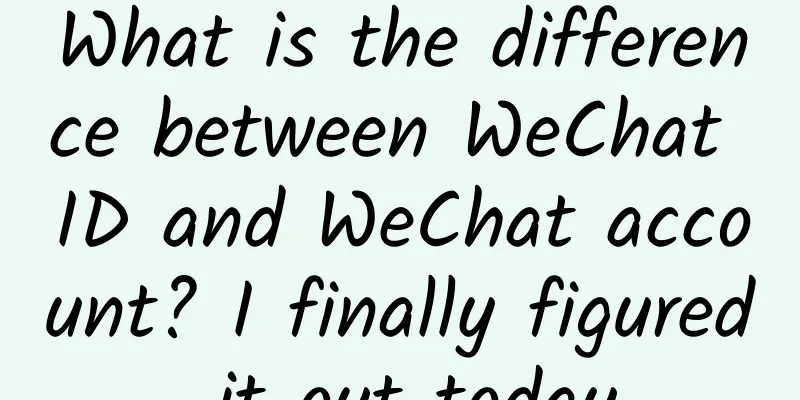An article to understand the product logic and strategic layout behind the Alipay 9.0 revision

|
About the Alipay 9.0 revision: If you only see the blue icon, you are still on the surface. If you also see words like “Dianping” and “WeChat”, then you have entered the superficial stage. If you can clearly see the business logic and strategic layout behind the product revision, then it can be considered as the heart appearance. Looking at the revision of Alipay from the five levels of user experience: strategy layer → scope layer → structure layer → framework layer → presentation layer. Strategic layer: connecting people and services The strategic layer is the foundation of all product experiences. First, we must clarify the product's business goals and user goals, and find a balance between profitability and user service. This is the product strategy. Essentially speaking, whether it is Alipay, WeChat, or Baidu (Baidu mobile + Baidu Maps), everyone is now doing the same thing, which is "connecting people and services", but the entry points are different and the cards in hand are also different. The slogan of connecting people and services was first shouted by Dianping. The history of the three BAT companies is all about "connection". Baidu connects people and information, Tencent connects people and people, and Alibaba connects people and goods. This is the first stage of connection. It was once predicted that connecting people and services is the seat of the fourth giant. Now it seems that the three BAT companies are trying to directly take the position themselves, which is the second stage of connection. If you ask what the third stage of connection is? Shirasaki believes that it should be the connection of everything in the era of the Internet of Things. Scope layer: connect all services related to "money" The most important thing for tool-type products is to build a usage scenario for the tool so that users will think of the product first in this scenario. Therefore, the operation of tool-type products should first use the thinking of scenario-based operation. Users will not think of shopping because they see Alipay, but will think of using Alipay when shopping. What if the payment scenarios are extended infinitely, and all the places where "money" is needed before are replaced by Alipay? In the early days, Alipay was the third-party-guaranteed payment tool for Taobao in the PC era. Later, Alipay wallets appeared on mobile phones, which are electronic wallets that do not require bank card numbers. Later, there were life services such as recharging phone bills, buying movie tickets, and credit card repayments, as well as financial products. What's next? Continue to run through all consumption scenarios. From this perspective, the direction of Alipay is to continue to do and strengthen this one thing: connecting all services related to "money". Structural layer: payment scenario analysis From the perspective of Alipay 9.0, Bai Qi summarized the usage scenarios that Alipay has currently covered: Basic functions: payment, collection, transfer, remittance Life services: mobile phone recharge, credit card repayment, take-out, life payment (water, electricity, gas, television, fixed-line broadband), city services (traffic violation inquiry, hospital registration, etc.), movies, taxis, air tickets, scenic spot tickets, game recharge, express delivery, bus card recharge (currently only supports Yangchengtong), campus card recharge, tuition payment, phone card transfer, and charitable donations. Financial management: Yu'ebao, Zhaocaibao, Yulebao, lottery, stocks, financial management tools (exchange rate calculation, deposit income, mortgage, bookkeeping) Business: Crowdfunding, Alibaba e-commerce (Taobao, Tmall) Social: red envelopes, intimate payments National credit reporting system (highest level): virtual credit card (Huabei), personal credit rating (Zhima Credit) Don’t underestimate the following seemingly ordinary usage scenarios. In China, many things related to money are not easy to promote, and there are deep interest chains behind them. Baidu also developed a product called Baidu Wallet. We once suggested to the wallet team that they should quickly support the recharge of Beijing Public Transport Card. Can't they learn how to use such a large market? Once it is launched, it will definitely beat Alipay. But the answer we got was: the idea is not important. This idea has been proposed by countless people, and I believe the Alipay team has also thought of it. But why didn't anyone do it? It's not because it is technically impossible, but because the Beijing Public Transport Group is unwilling to connect with you, and you can't do anything about it. So when everyone saw these life services associated with Alipay, especially the acquisition of Guangzhou's Yangchengtong and Campus Card, Bai Qi admired Alipay's offline business development team very much. In the financial services, influenced by the domestic A-share market, it is expected that Alipay will continue to focus on the stock sector in the near future. Once the connection is successful, the prospects are very promising. In the A-share market, the money in the stock account is placed in a third-party custodian bank. What does Alipay want to do? Replace the bank! In the future, everyone's stock trading money will be directly managed by Alipay. Let's talk about the most advanced national credit system. This is Alibaba as a company doing the government's work. Virtual credit cards, lending money directly to you, firmly tying you to Alipay, is another step to defeat banks. Sesame Credit, people don't see its power yet, but in the future, when you apply for a visa abroad, get a loan to buy a house, everything will be based on your credit score. This is a very mature system in the United States. It was originally the government's business, but Alipay took the lead in completing it. So in the end, Alipay became the carrier that connects all money-related services, and it is omnipresent, from life services to financial management, to the national credit system. No matter where it is, Alipay can always meet the needs of users. Framework layer: how to arrange these usage scenarios The framework layer is the information structure of the product. It focuses on how users understand and use the product, and the user behavior. It includes interface design, tab navigation pages, etc., that is, how to arrange the usage scenarios that users can see. Why did Alipay make this adjustment?
How to connect people and services: define scenarios and connect relationships As for the usage scenarios, we have analyzed a lot above, so let’s focus on the connection relationship. Alipay mainly carries three kinds of social relationships: Merchants and users: This is the most primitive relationship connection, which exists between Taobao merchants and buyers, and Alipay acts as a payment tool. Platform and users: This is the relationship that was connected after Alipay introduced life services, so there is a service window as an open platform. When many service providers settled in Alipay, it rose from a simple tool to a platform, and Alipay became the center. Users and users: The newly added "friends" in the latest version 9.0, each user is a central point, which means decentralization. Moving the "Merchants" and "Friends" modules to the first-level tab page represents two major directions of transformation: Why should merchants be brought forward? O2O is the service with the highest frequency of use in payment scenarios in the personal consumption field. It solves the problem of non-high frequency of products, so it needs to be moved to the first-level tab in advance. The same is true for Baidu Mobile. The second tab page after the search page is "Nearby", and clicking on it will take you to Baidu Nuomi's life service. Why bring friends forward? I think this is a battle against WeChat Pay, not WeChat. Alipay is not good at social networking, but it has to solve the problem of low frequency. Therefore, there is a chat window similar to social products, and some new usage scenarios between users are also built. What needs does the newly added chat window solve: the problem of information fragmentation in person-to-person payment scenarios. Think about what we do now? First transfer money on Alipay, then go to WeChat to ask if it has been received? See, it still goes to that little bitch on WeChat. Why can't we complete the communication directly in Alipay? Alipay's social relationship chain is based on mobile phone contacts, that is, the social relationship of acquaintances. When will the relationship between acquaintances be related to money? New payment scenarios based on social relationships: AA for food, drink and entertainment. Alipay provides the following reference scenarios: funding group, food group, activity group, and entertainment group. In the payment scenario, there are already various relationship chains between friends and between users and merchants that need to communicate. Alipay just fills this link. If the only use scenario for WeChat Pay is the red envelope function, then there is nothing to worry about. After all, Alipay has always had a strong advantage in offline business expansion and has not yet posed a substantial threat. Presentation layer: UI vision Most people have noticed why the color was changed to blue? Actually, this is the least important part, but it attracts the most attention. Only children talk about whether the interface is good-looking or not, while adults only see the business. 1. The merger of Alipay and Alipay Wallet If most people did not notice this merger, it means that they no longer have much perception of the Alipay PC version logo.
The unification of the main visual effects of PC and mobile terminals is also a manifestation of integration. 2. Purple Cow Theory: Please pay attention to me The Purple Cow Theory comes from "Purple Cow: From Obscurity to Distinction", and the author Seth Godin explains it this way: When you see a huge black and white cow with smooth fur in the mountains, you feel it is magnificent and beautiful. As you drive into the mountains, you see magnificent cows everywhere. It is fresh at first, but then it becomes ordinary. Although these cows are very good, after seeing so many of them, you no longer feel anything. If a purple cow appears at this time, as long as it appears once, you will remember this scene for the rest of your life. Later, the book used the concept of purple cow to constantly tell everyone to do marketing that is unforgettable. In this mobile phone, APP icons are concentrated in red, orange, green and blue. Alipay chose blue, which is a manifestation of being a purple cow. As for why it is blue? Who TM cares, as long as it is convenient for you to find it among a bunch of APPs. |
<<: Google open-sources Eddystone BLE beacon communication format to challenge Apple
>>: A good article to solve your doubts: HD multi-screen adaptation solution for mobile H5 pages
Recommend
International Cheetah Day丨It’s the king of speed and has a strong “gang of men”, but this “big cat” is not happy?
It has a slender body, sometimes elegant, sometim...
Xiaohongshu virtual money-making project, no technical content, daily income 100-200
Why do I keep emphasizing virtual projects? Becau...
Mozilla CTO publicly blames Android and iOS
[[122515]] In a report provided to The Guardian, ...
How does Bilibili’s interactive video marketing promotion work?
On July 8, Bilibili officially announced the laun...
4 million people died prematurely! How can cooking at home still cause serious pollution?
A study recently published in International Envir...
Event Operations: Grasp these 5 points to increase online event participation
A popular online event can not only directly brin...
How to write excellent promotional copy?
For many operations and promotion personnel, crea...
Eat 8,400 bacteria in one bite? A must-eat food in summer nearly killed a family of three!
Just ask yourself, in this hot summer season, who...
Price inquiry for Zhangzhou Aquatic Products Mini Program agent. How much is the price for Zhangzhou Aquatic Products Mini Program agent?
For entrepreneurs, although mini program developm...
The relationship between host speed and SEO
In addition to affecting the website's user e...
Volkswagen and Mobileye team up to implement autonomous driving and will launch driverless taxi service next year
On October 30, foreign media reported that Volksw...
"SEO training institution" SEO bookshelf exclusively reveals the black hat SEO order-taking industry!
"SEO training institution" SEO bookshel...
The entire process of listing on the App Store
App Store listing refers to the entire process of...
Practical traffic diversion skills for Douyin (Part 1)
In order to help you learn the course better, tod...
Should you turn on iOS privacy tracking? You will understand after reading this
The official version of iOS14.5 has been released...









